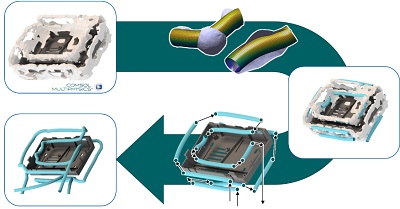Subject of the work
Nowadays, the temperature control of injection moulds is mainly carried out via cooling channel systems in the mould, through which a fluid is guided. The layout of the cooling channels directly influences the amount of heat that can be dissipated, so that the temperature control system is increasingly in the focus of industry and research, also due to increasing demands on the achievable component qualities and shorter cycle times.
In a current research project, an algorithm is being developed that can calculate the optimal cooling requirement. From this, the optimal location of the cooling channels can be determined. The described algorithm indicates the location of the cooling channels in the form of surfaces. These surfaces must now be converted into a cooling channel system that is suitable for production and processes. Initial approaches to this exist on the basis of a Matlab script, which must be further developed and improved and a transfer to a Python environment needs to be tested (see image).
The work is related to this research project:
In this sub-project of a large cooperative project of various institutes of the RWTH, a methodology is being researched that automatically calculates the optimal cooling channel layout. The aim is to compensate for moulding distortion during injection moulding and to enable higher moulding precision.
Target:
The aim is to optimise and extend the current algorithm for deriving sensible cooling channel layouts for injection moulds. The geometry-independent applicability is to be ensured in order to complete the degree of automation of the design routine.
This could be your task:

